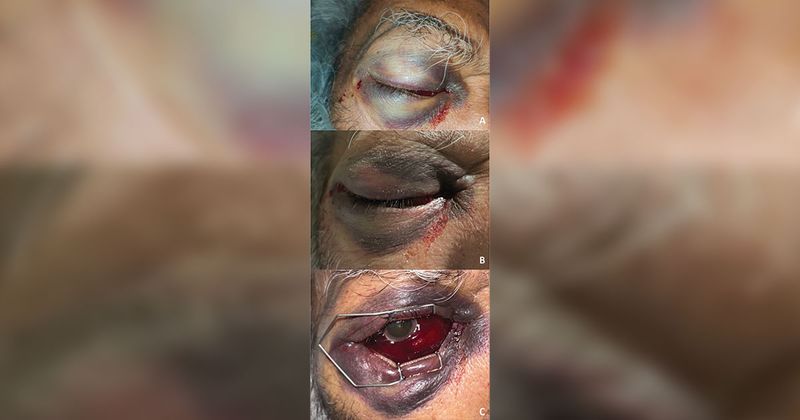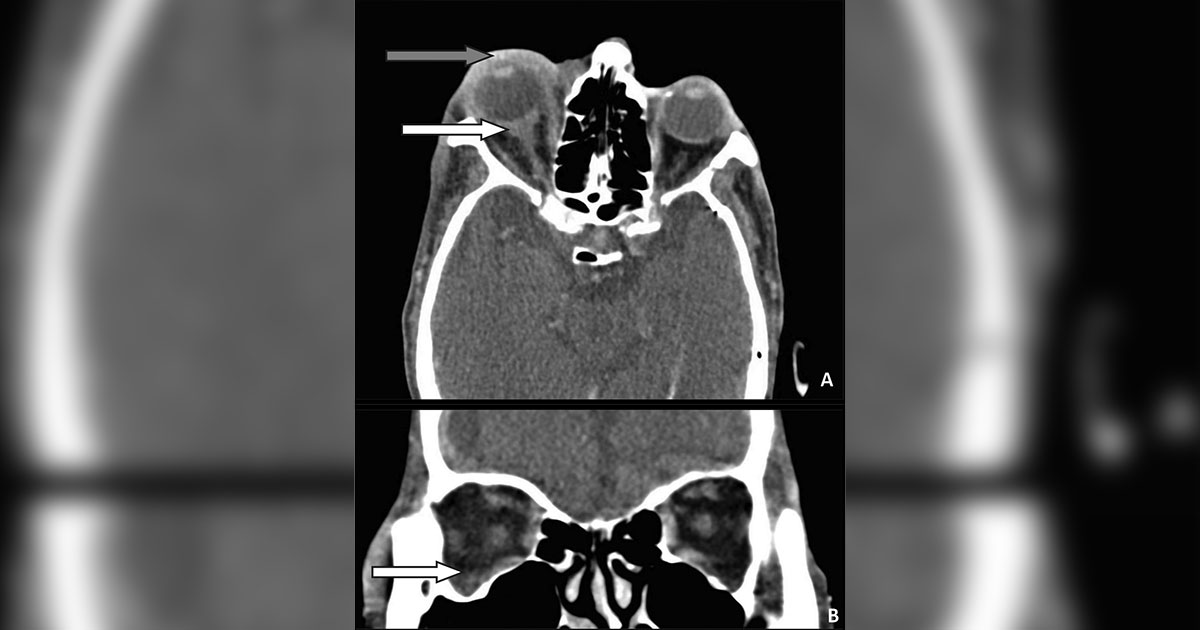Man develops sudden onset right eye pain and ecchymosis
The ophthalmology service at Tufts Medical Center was consulted urgently to examine a hospitalized 78-year-old man at bedside who had developed sudden onset severe right eye pain and ecchymosis while asleep in his hospital bed.


The patient had no ocular or surgical history and was not on any eye medications. His medical history included chronic kidney disease, type 2 diabetes, myelodysplastic syndrome, systemic macrocytosis, chronic thrombocytopenia, recurrent epistaxis, alcohol use disorder and cirrhosis. During his current and prolonged hospitalization, the patient was diagnosed with a new gastric adenocarcinoma and received multiple blood, platelet and cryoprecipitate transfusions for bleeding esophageal varices. His mental status and overall health had deteriorated to the point where he no longer had decision-making capacity, and his health care proxy was activated. There was no pertinent family history, and the patient had previously worked as a taxi driver. He had not experienced any recent traumas or invasive procedures.

Prior to ophthalmology evaluation, the patient’s primary team had initiated goals of care discussions with his family due to a low likelihood of recovery from his terminal illness and several comorbid conditions.
Examination
Upon gross initial examination, the patient was found to have an extensive right-sided periorbital hematoma (Figures 1a to 1c). He was unable to spontaneously open his eyes, so an eyelid speculum was placed for further assessment. Best corrected visual acuity with hyperopic correction measured 20/100 in the right eye and 20/60 in the left eye. IOP was 37 mm Hg in the right eye and 16 mm Hg in the left eye measured by handheld Tono-Pen tonometer (Reichert). The right pupil was mid-dilated and minimally reactive to light without a noticeable relative afferent pupillary defect. The patient had restricted motility in all gazes in the right eye, and he was unable to cooperate with confrontation visual fields. Color vision appeared grossly intact as the patient correctly identified the first 4/12 numbers on Ishihara color plates until he stopped cooperating with the examination.
Anterior segment examination revealed 360° subconjunctival hemorrhage and chemosis with limbal clearing. Scant blood was draining at the lateral canthus. On portable slit lamp examination, the right cornea appeared clear without edema, the anterior chamber was well formed, no hyphema or hypopyon was present, and there was a moderate age-related nuclear cataract.
Posterior segment evaluation revealed no evidence of vitreous hemorrhage. The optic nerve appeared healthy with sharp disc margins and no evidence of ischemia or hemorrhage. The macula had some scattered drusenoid changes. The retinal periphery was unremarkable. The left eye was unremarkable except for a symmetric moderate age-related cataract.
What is your diagnosis?
Acute onset eye pain
The most likely etiology for this patient’s acute onset eye pain, periorbital hematoma and gaze restriction is a retrobulbar hematoma in the setting of his severe thrombocytopenia. Despite the absence of any recent trauma, he had a history of spontaneous bleeds and most likely experienced a rupture of a fragile retrobulbar venous vessel during his hospitalization.
Workup and management
Multiple unsuccessful attempts were made to reach the patient’s health care proxy to reassess goals of care, given the possibility of requiring surgical intervention to control bleeding should a bedside lateral canthotomy and cantholysis be performed. After discussion with the hematology team, the decision was ultimately made to not proceed with the procedure, given an IOP of less than 40 mm Hg and the absence of any signs of optic nerve ischemia. Furthermore, it was apparent that given the patient’s terminal illness, history of severe thrombocytopenia refractory to resuscitation, and unstable hemodynamic profile, he was unlikely to tolerate anesthesia or any invasive surgical intervention.
The patient was therefore immediately started on brimonidine and dorzolamide/timolol eye drops for conservative management of his acutely elevated IOP. A stat CT scan of the head and orbits with and without intravenous contrast was ordered. After two rounds of drops, his IOP decreased to 27 mm Hg, and the CT scan demonstrated evidence of a right-sided retrobulbar and intraconal hemorrhage with associated preseptal hematoma and marked proptosis (Figure 2). A stat complete blood count (CBC) showed severe thrombocytopenia with a platelet count of 11 K/uL, which did not improve despite multiple platelet and cryoprecipitate transfusions.

Discussion
Spontaneous retrobulbar hematoma (SRH) is an exceptionally uncommon vision-threatening emergency. Typically, orbital trauma, ocular surgery or retrobulbar injections predispose patients to retrobulbar hemorrhage. Even more rarely, blood and vascular abnormalities, dyscrasias (thrombocytopenia, myelodysplastic syndrome), liver failure (cirrhosis) and excessive Valsalva maneuvers can lead to a spontaneous orbital bleed. In a large retrospective study, nontraumatic SRH secondary to coagulopathy accounted for only 0.001% of all retrobulbar hematomas over a 24-year span.
Typically, patients with spontaneous bleeds have an underlying, undiagnosed vascular abnormality. On further review of our patient’s records, 1 year before presentation, he experienced a spontaneous aural and intracranial bleed, and workup at that time showed no evidence of any vascular malformation. In this situation, the patient most likely experienced excessive Valsalva pressure through a sneeze or bowel movement. The increase in intrathoracic and intra-abdominal pressure against a closed glottis increases stress on the non-valved orbital veins, resulting in increased congestion, decompensation and perforation. The patient’s thrombocytopenia subsequently resulted in the accumulation of blood in the retrobulbar space, increasing IOP and causing his symptoms.
Management of SRH with an underlying coagulopathy can be challenging. In most cases, if there is concern for orbital compartment syndrome, a lateral canthotomy and cantholysis is performed to relieve retrobulbar pressure to prevent optic nerve ischemia. One case report described SRH due to thrombocytopenia in the setting of rivaroxaban use. In this case, a lateral canthotomy and cantholysis was performed. However, the lateral canthotomy site continued to bleed for several hours, at one point resulting in hypotension requiring IV resuscitation and rivaroxaban reversal. Another case report described a thrombocytopenic patient who suffered a SRH with a platelet count of 9 K/uL in the setting of thrombocytopenic purpura. The patient was successfully treated medically, avoiding the high hemorrhagic risk of lateral canthotomy and cantholysis. In patients in whom surgery poses high risks and there are no signs of optic nerve ischemia, it may be more appropriate to treat medically and monitor for signs of progression with serial examinations.
Case resolution
The next day, the patient’s visual acuity remained stable, and his IOP decreased to 22 mm Hg after being started on dorzolamide/timolol twice daily and brimonidine three times daily. The periorbital hematoma began to spontaneously resolve to the point where he could open his right eye unassisted. After the events of the previous night, the patient’s health care proxy ultimately decided to make the patient comfort measures only. The patient died 7 days later.
This case demonstrates an unusual presentation for a retrobulbar hemorrhage and the decision-making process regarding performing lateral canthotomy and cantholysis in a thrombocytopenic patient.
- References:
- Brewer DC, et al. Emergency Medicine. 2016;doi:10.12788/emed.2016.0040.
- Deveer M, et al. Case Rep Radiol. 2015;doi:10.1155/2015/796834.
- Lima V, et al. Surv Ophthalmol. 2009;doi:10.1016/j.survophthal.2009.04.005.
- Sousa FC, et al. BMJ Case Rep. 2017;doi:10.1136/bcr-2017-223028.
- Sullivan TJ, et al. Clin Exp Ophthalmol. 2000;doi:10.1046/j.1442-9071.2000.00241.x.
- For more information:
- Edited by Jonathan T. Caranfa, MD, PharmD, and Angell Shi, MD, of New England Eye Center, Tufts University School of Medicine. They can be reached at jcaranfa@tuftsmedicalcenter.org and ashi@tuftsmedicalcenter.org.
